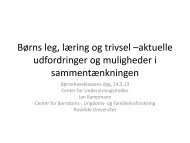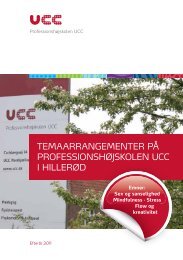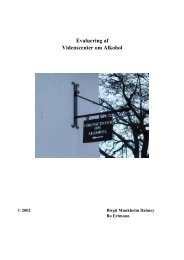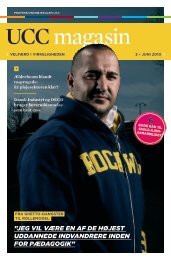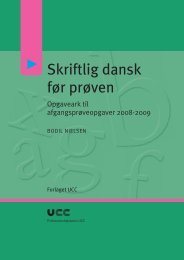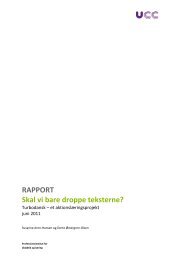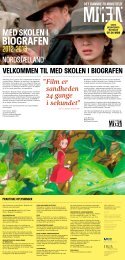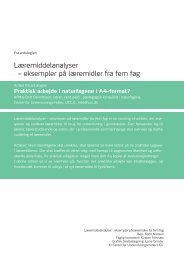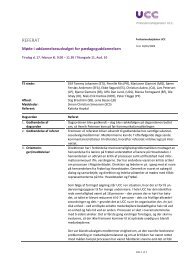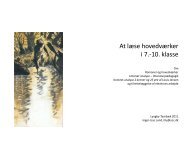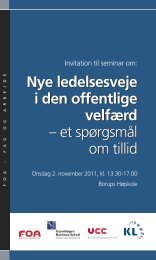AGORA - tidsskrift for forskning, udvikling og idéudveksling i ...
AGORA - tidsskrift for forskning, udvikling og idéudveksling i ...
AGORA - tidsskrift for forskning, udvikling og idéudveksling i ...
Create successful ePaper yourself
Turn your PDF publications into a flip-book with our unique Google optimized e-Paper software.
<strong>AGORA</strong> - <strong>tidsskrift</strong> <strong>for</strong> <strong>for</strong>skning,<br />
<strong>udvikling</strong> <strong>og</strong> <strong>idéudveksling</strong> i professioner<br />
as a symbol” (Gendlin, 1997, 8). This symbolization often happens in a verbal <strong>for</strong>m, but it can be<br />
expressed by other means (e.g., movement, art, drama, dance, thinking or writing).<br />
• Finally, meaning has a narrative and social dimension, and here, meaning can develop a dynamic<br />
which is less connected to the basic individual experience, but evolves in a process of co-creation<br />
where individual meanings meet those of others and shape a third something which is anchored in the<br />
social setting or the community of practice (Wenger, 1998).<br />
In that sense, the concept of meaning integrates the experiential and pre-reflective dimension on the one<br />
hand and the discursive, narrative and community based dimension on the other.<br />
Body-anchored and experience-based learning as being embedded in the community of practice<br />
In the following section, body-anchored and experience-based learning will be considered as being a<br />
part of the social realm. Learning very seldom happens isolated from others, but is mostly integrated in<br />
a social setting or culture with specific rules, norms, action patterns, etc. Wenger (1998) defines such a<br />
setting as a community of practice, which he characterises through the following three dimensions:<br />
1. Mutual engagement<br />
Wenger (ibid.) underlines that “practice does not exist in the abstract. It exists because people are<br />
engaged in actions whose meaning they negotiate with one another” (p. 73). The participants in the<br />
community of practice are involved by contributing complementarily. In that sense, an individualistic<br />
perspective of learning is replaced by a community-orientated perspective. This change of viewpoint<br />
places individual experience as an integrated and social component of the learning field.<br />
2. A joint enterprise<br />
Every community of practice is based on a collective process of negotiation. Every participant in<br />
the community has to pursue involvement and show interest in the others. There has to be a mutual<br />
accountability which includes – beside other things – “what matters and what does not, what is important<br />
and why it is important, what to do and not to do, what to pay attention to and what to ignore” (Wenger,<br />
1999, 81).<br />
3. A shared repertoire<br />
The joint enterprise in the community of practice creates resources <strong>for</strong> negotiating meaning and develops<br />
a shared repertoire which “includes routines, words, tools, ways of doing things, stories, gestures,<br />
symbols, genres, actions or concepts that the community has produced or adopted in the course of its<br />
existence” (ibid., p. 83).<br />
Earlier in the article, meaning-making has been rec<strong>og</strong>nized as one of the central premises <strong>for</strong> bodyanchored<br />
and experience-based learning. On this individual level, meaning evolves by embodying the<br />
world, by relating oneself actively to the context and by understanding and reflecting on the situation<br />
through situated action. In a community of practice, meaning evolves on a “higher” level, a level where<br />
we can speak about co-creation of meaning. In communally based situated action the individual meets<br />
other individuals, each basically with their understanding of the situation. But when they are part of a<br />
community of practice, people negotiate meaning while acting t<strong>og</strong>ether. The individual meaning is put in<br />
the background and goes over as an integrated part of co-created meaning. Wenger (1998) describes this<br />
process as follows:<br />
“… We produce again a new situation, an impression, an experience. We produce meanings<br />
that extend, redirect, dismiss, reinterpret, modify or confirm – in a word, negotiate anew<br />
– the histories of meanings of which they [the members of the community of practice] are<br />
part” (pp. 52-53).<br />
On the basis of a situated approach, Wenger portrays meaning through two central dimensions:<br />
participation (described by living in the world, membership, acting, interacting, mutuality), and<br />
www.cvustork.dk/agora/ 13





